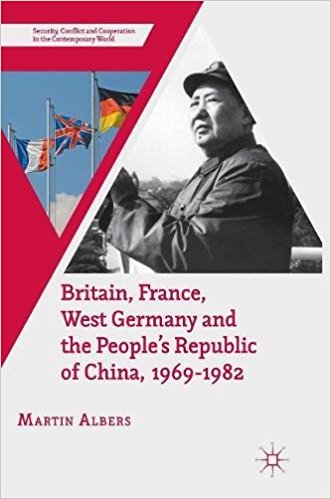
Britain, France, West Germany and the People’s Republic of China, 1969-1982: The European Dimension of China’s Great Transition by Martin Albers
 Martin Albers, in the introduction to this volume, sets himself a number of aims: to explore an under-researched area in the relations between Europe and China (PRC), to deploy evidence not only from government sources in western Europe but also from firms and other non-state actors, to bridge between a comparativist and an international historical approach, and to explore the commonalities between the positions of France, Germany, and Britain, as well as the differences between them, in meeting the challenge of developing relations with the People’s Republic in the era of both détente and the “new Cold War.” This is an ambitious agenda, but to a large degree Albers succeeds in pursuing it, and in doing so provides an invaluable guide to a period that is now largely forgotten.
Martin Albers, in the introduction to this volume, sets himself a number of aims: to explore an under-researched area in the relations between Europe and China (PRC), to deploy evidence not only from government sources in western Europe but also from firms and other non-state actors, to bridge between a comparativist and an international historical approach, and to explore the commonalities between the positions of France, Germany, and Britain, as well as the differences between them, in meeting the challenge of developing relations with the People’s Republic in the era of both détente and the “new Cold War.” This is an ambitious agenda, but to a large degree Albers succeeds in pursuing it, and in doing so provides an invaluable guide to a period that is now largely forgotten.
The book is undoubtedly a historical study, but in pursuing a wide-ranging account of the years 1969-1982, it suggests a number of important themes for the non-historian, especially the student of International Relations. Structured around three periods within the overall time-frame, the argument covers a period of “political opening” between 1969-1973, a second and transitional period between 1973-1977, and a final period, which Albers suggests laid the foundations for the subsequent transformation of Europe-China relations and for the rapid development of globalization, between 1978-1982. These are also, of course, periods of major change in the international arena more generally, between détente and the new Cold War, and Albers rightly points out that the changing international structure has a major role to play in the diplomacy of the three European countries, as well as in the Chinese adjustment to evolving threats and opportunities. His focus is primarily on the European dimension, since a detailed study of Chinese foreign policy in the 1970s would demand both a new book and a level of engagement with China and Chinese texts available to few European (or western) scholars. Nonetheless, Albers is able to provide important insights into the interplay of domestic and other forces in Chinese foreign policy, and into the ways in which these played into the framing of European responses.
The book begins by painting the historical back-cloth to the more detailed study in its later parts. Albers draws out effectively the different “legacies” affecting Britain, France, and West Germany, especially in relation to earlier encounters with China and to the aftermath of empire. Essentially, he argues, Britain was still in many respects “imperial” in the 1970s, in terms of its presumptions and its diplomatic style; France, on the other hand, had a more complex relationship with China, framed in part by the fact that it had provided a refuge for important Chinese Communist leaders during the 1930s and beyond; and Germany, whilst intervening in a number of ways, had also shaped the educational and other systems in China in ways not attempted by the British and French. Common to each of the three European countries was their impact through modernization, but their relationships to China after World War II were on the face of it very different: whilst the British recognized the PRC at a very early stage, the French did not do so until the 1960s, and the Germans until the early 1970s. One key element in this set of disparities was the structure of the Cold War, and the constraints it placed on European countries during the 1950s and 1960s, both through US foreign policy and through the overall power structure, but in each of the three cases there were other constraining factors: the need to defend Hong Kong in the British case, Indochina for the French, and the preoccupation with domestic recovery in the case of the Germans. This theme of common constraints but very different policy trajectories is a key element in the overall argument of the book, and it comes through strongly here.
From chapter three onwards, the book provides three pairs of chapters; in each case, the first chapter is focused on conventional diplomatic contacts and interactions, whilst the second deals with economic and cultural links, in which it might be expected that not only governments but also a range of non-state actors would have significant roles as relations developed. Thus, chapters 3-4 deal with the period 1969-72, in which the development of European détente, the last throes of the Cultural Revolution in the PRC, and the subsequent “opening” to the rest of the world, formed a particular opportunity structure for European governments and firms. Albers shows well the ways in which French policies were shaped not only by the international structure but also the ways in which French leaders aimed at a certain role within the world arena; for Britain, on the other hand, post-imperial conflicts and a certain view of their role in relation to the USA formed key constraints, whilst for Germany (which did not recognize the PRC until 1972) private contacts and networks were a key channel for activity. Not surprisingly, the politicization noted in chapter 3 played a key role in the economic and cultural processes detailed in chapter four, but Albers also points to the differing roles played by the British, French and German states in either building on diplomatic advantage, by-passing governmental constraints or attempting to support firms in their initial attempts to penetrate China. A key theme becomes apparent here: the German preoccupation with economic activities, and the constraints implied in the lack of formal German-Chinese relations, shaped an economic diplomacy largely carried on through firms or industrial associations, and this was arguably more effective than the more politicized strategies pursued by the British and the French.
This theme – of British and French inability to overcome the political constraints within which they were operating, and of German ability to focus more sharply on economic and commercial advantage – persists through chapters 5-8, which cover the mid-1970s and then the late 1970s/early 1080s. But there is also another key theme: that the net effect of the attempts by all three European countries to establish constructive relations with China was to shape a wider form of stability for the development of Chinese domestic and foreign policies. Albers argues that this was a key factor in the development of the Chinese economy, and thus in the ability of the Chinese to enter in globalization when it really took off in the late 1980s and 1990s. Although each of the three European countries adopted different styles of diplomacy, the overall effect was to provide a vital element in the context for Chinese development. Thus, although the very high hopes that some had for the development of the Chinese market were not fulfilled in the 1970s and early 1980s (and have arguably still not been fulfilled), the foundations were laid for China’s engagement with the world economy and for its emergence as a leading exporter around the turn of the millennium. Chapters 5 and 6 detail the efforts made by the British and French especially to establish and maintain high-level diplomatic contacts with Beijing, and the ways in which this was affected by the development of China’s relations with the Soviet Union, whilst in the case of Germany attention is drawn to the ways in which the relationship with China played into the relationship between Bonn and Moscow, giving Germany leverage in developing both economic and cultural contacts. Again, the central theme emerges – that Germany, without the global or imperial diplomatic pretensions of the French and the British, was better able to capitalise on the economic and cultural contacts with the PRC and to avoid the security issues that attended both the British and the French attempts to sell aircraft and arms to Beijing. Albers argues that there is little evidence of strategic and coordinated efforts by any of the three European countries, but that German pragmatism and the lack of central government direction was advantageous – and it is difficult to disagree.
Chapters 7-8 deal with the transition between 1978-1982, when the Chinese opened up more to outside powers but at the same time the international atmosphere was soured by the “second Cold War” precipitated by the Soviet invasion of Afghanistan and related events. In this context, both Japan and the US (the latter belatedly) maintained or developed strong positions in China, and the three European countries were thus challenged in new dimensions. The idea that the ‘China card’ might be played against the Soviets – or against any form of US-Soviet rapprochement – was evident, but not pursued in a sustained fashion. As in other periods, the French found it difficult to balance conflicting needs – in this case, their desire for greater leverage in China via arms sales and other avenues with their priority for the maintenance of European détente. The British were constrained in any attempt to boost arms or high-technology sales to China by the US and by the CoCom controls on technology transfers, and were increasingly preoccupied with the fate of Hong Kong as 1997 and the end of their lease approached. The Germans, on the other hand, were increasingly able to take advantage of industrial and commercial networks built up in earlier periods, and also of the Chinese admiration for a ‘German model’ of economic recovery and development. As before, Albers argues persuasively that the overall effect of the three European countries’ differing responses to the challenges and opportunities was a net increase in stability, at the same time as the three experienced significantly different levels of diplomatic success. In this context, it is difficult to avoid the conclusion that on purely commercial grounds, the German ability to engage at the level of industries as well as to provide a model of industrial success was crucial when it came to the “contest” for influence in the Chinese process of development. The effects of this positioning can be seen to this day in the dominant position of Germany among EU member states in terms of trade with and investment in the PRC.
The argument advanced by Albers thus has three key strands, summarized in his Conclusion. First, international structure mattered, in terms of the Cold War confrontation and the capacities of the three European countries to adapt to or take advantage of changes on the level of international tension. Second, states and governments mattered, both in terms of formal diplomacy and in terms of their capacity to mobilize or support non-state groupings (a quality shown to be most effective in the case of West Germany, despite the use of state power and resources by both the British and the French at different times). Finally, the Chinese mattered, in terms of their domestic challenges and their capacity to take advantage of the initiatives produced by the Europeans. As Albers also proposes, history mattered, when it came to the different historical connections and legacies affecting both European perceptions of China and Chinese perceptions of their European suitors. It is to Albers’ immense credit that he has managed to identify, pursue and develop these strands of argument in a consistent and effective way, using a wide range of sources and applying a sophisticated historical sensibility. In doing so, he has provided a strong basis for further research into the relations of European countries with one of their most challenging partners.
Reviewed by Michael Smith, University of Warwick
Britain, France, West Germany and the People’s Republic of China, 1969-1982: The European Dimension of China’s Great Transition
by Martin Albers
Publisher: Palgrave Macmillan
Hardcover / 2016 / 341 pages
ISBN 9781137565662
Published on July 31, 2017.




